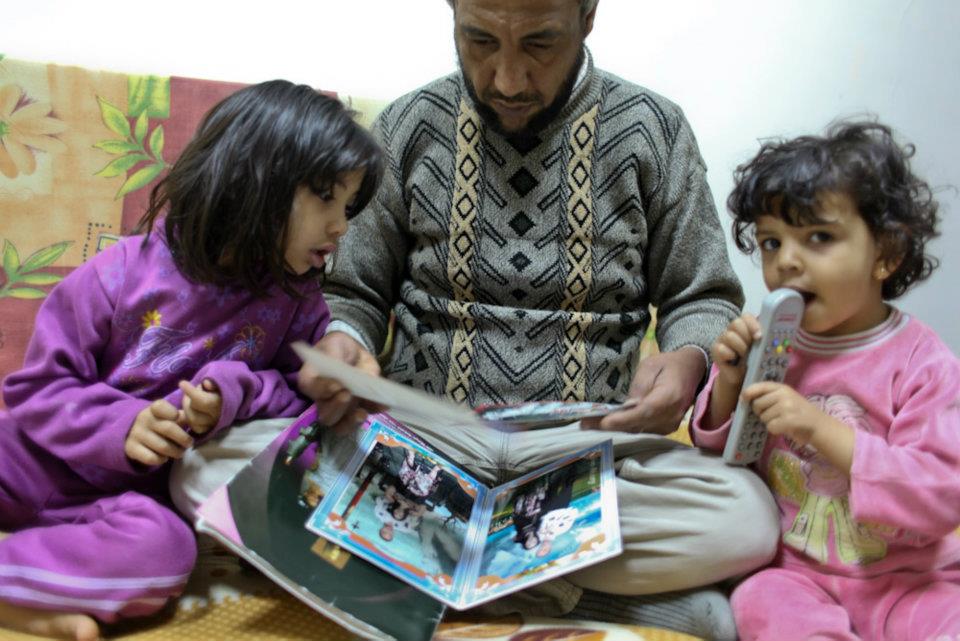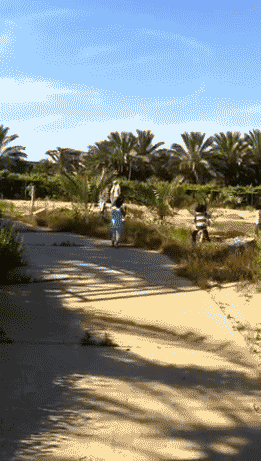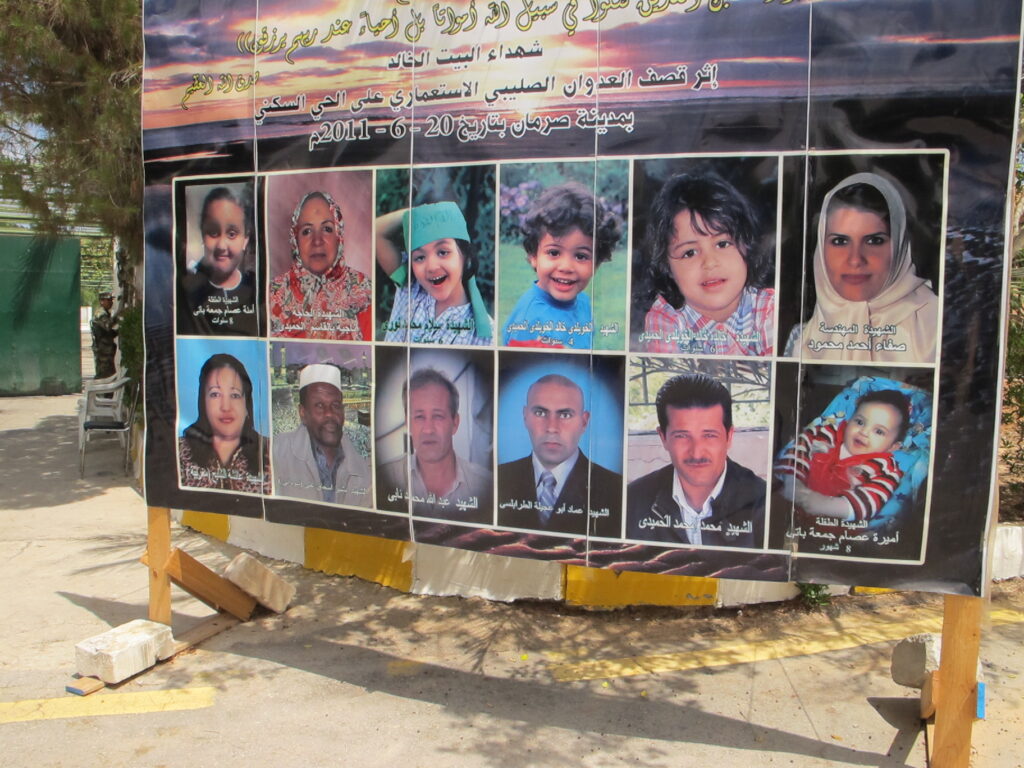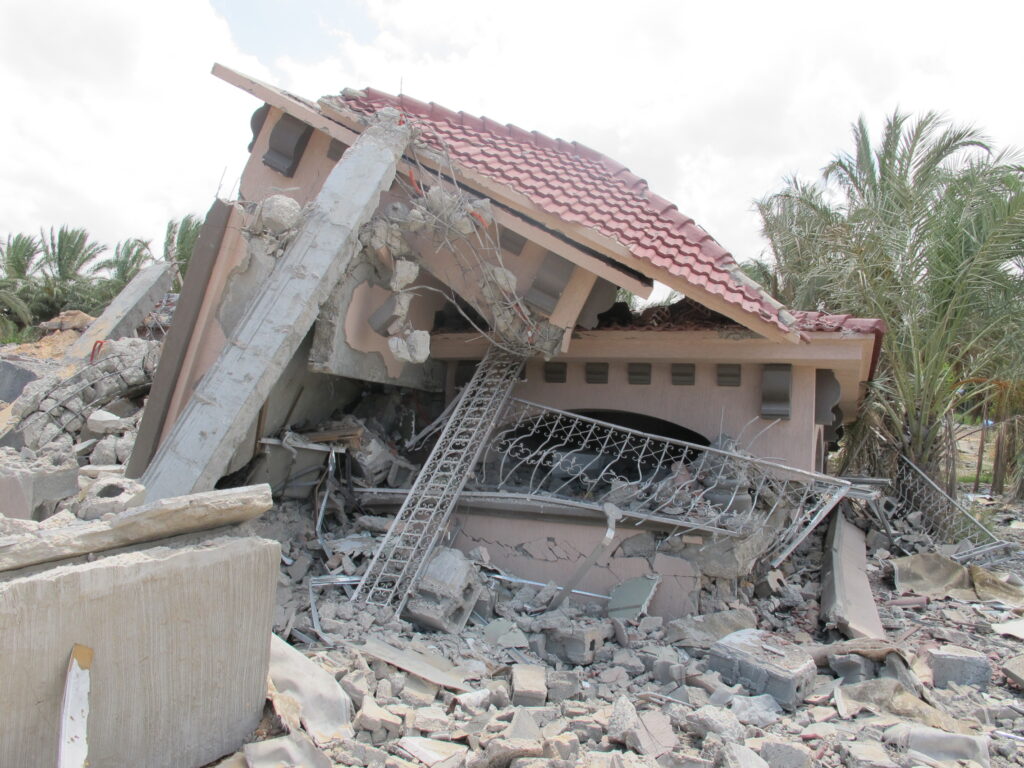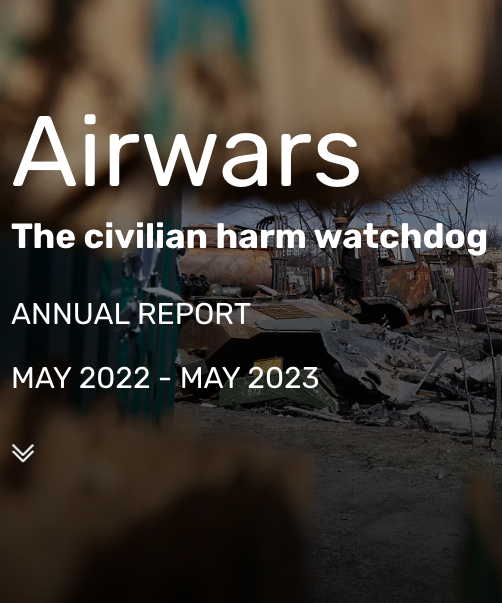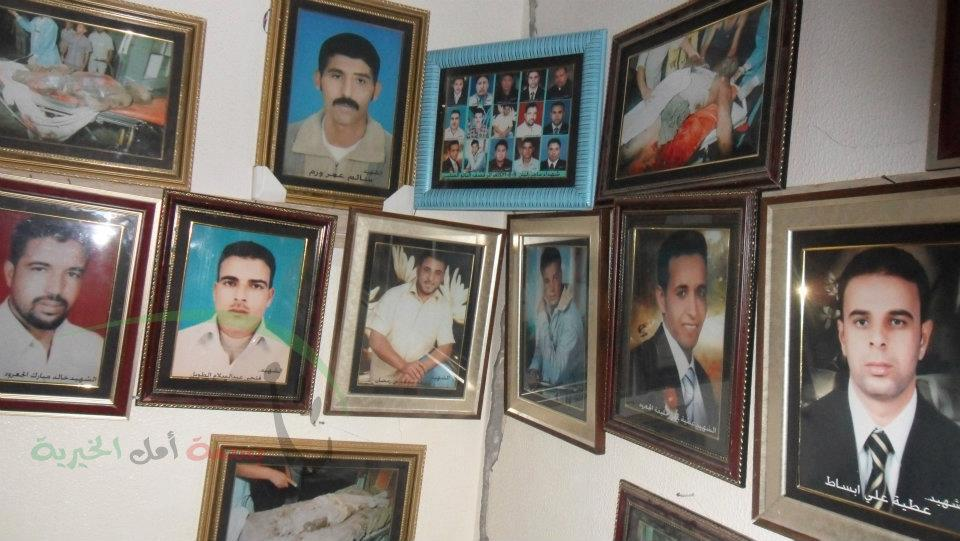Newly released documents definitively link Danish war planes to strikes that killed Libyan civilians
A joint investigation by Airwars, the Danish news site Altinget and The Guardian has sparked a review of civilian harm allegations from Danish airstrikes in the 2011 war in Libya.
Published on January 25th, the two-year investigation revealed the existence of a previously secret Danish internal review of allegations of civilian harm from its more than 900 bombs dropped as part of the NATO campaign against Colonel Muammar Gaddafi. The military review found Danish pilots conducted strikes in incidents in which at least 14 civilians were killed. The document was produced in 2012, a year after the war, but kept from the Danish public for more than a decade.
The revelations are the first time a particular NATO country has been definitively linked to specific airstrikes that harmed civilians in Libya. You can read the news stories in English (Guardian) or Danish (Altinget), and find the full story behind the investigation.
The investigation was lead story on The Guardian’s website on January 25th
In a direct response to the investigation, Danish Minister of Defence Troels Lund Poulsen ordered the Danish Armed Forces to commit a formal review of the allegations. A top Norwegian official said such civilian harm was “unsurprising” as NATO’s targeting information was limited during the campaign in Libya.
Several Danish political parties have called for the government to establish a compensation model for civilians harmed, with Christian Friis Bach from the Radikale, emphasising: “If Danish soldiers become aware that they have conducted an airstrike resulting in unintended civilian casualties, then you should proactively take responsibility and reach out with a compensation model that has been established before the incident takes place”.
The investigation also sparked an intense conversation on the possibility of a ‘cover up’ in Copenhagen – with a focus on who knew about the internal review and when. Both the foreign minister and the defence minister at the time that the Danish armed forces concluded their review said they do not recall being briefed about the reports. The foreign minister emphasised he would have remembered, had he been told, while the defence minister referred follow-up questions to the ministry.
Then head of NATO, Rasmus Fogh Andersen – a former Danish prime minister – has refused to comment. Former Danish defence minister Hans Engell hailed the “skilful” investigation, but said the apparent cover up “threatens the credibility of the armed forces” in Denmark.
In Libya, the renowned Arabic paper Asharq Al-Awsat reported a number of politicians and human rights activists calling for action against Denmark to seek compensation for the victims.
Since the 2011 air campaign in Libya, Denmark has contributed to several international coalitions, including the anti-ISIS coalition in Iraq and Syria, which Airwars estimates led to at least 8,199 civilian casualties.
In late 2023, Denmark joined the US-led ‘Operation Prosperity Guardian’ campaign targeting the Houthi forces in Yemen, in a supporting capacity. It is unclear what civilian harm mitigation tools are applied in this campaign and whether systems have been established for civilians to report potential harm from airstrikes.
Emily Tripp, Airwars’ director, said: “This investigation reveals once again that a failure in transparency over civilian harm allegations does a disservice both to the citizens in whose name such wars are fought, and to those civilians who deserve answers about which nation killed their loved ones.
“The fact that Danish officials went to the trouble of reviewing these allegations is actually a positive: very few NATO allies engage with external allegations at this level. But refusing to then share those findings with the public raises serious questions about political processes and practices both in Denmark and in the wider NATO campaign.”
Below is a list of some of the articles about the investigation
English
Denmark admits role in Nato airstrikes on Libya that killed 14 civilians in 2011 (Guardian)
How we exposed secretive Danish role in Libyan civilian deaths (Airwars)
Danish
Armed forces kept reports secret for years: Denmark likely killed civilians in Libya (Altinget)
After revelations: the Ministry of Defence reopens its Libya investigation after more than 10 years (Altinget)
Parties in the aftermath of the Libya disclosure: Denmark should prepare for possible lawsuits (Altinget)
Podcast: How it was revealed that Denmark likely killed civilians in Libya (Danish)
‘Son of a bitch!’ exclaims former UN investigator: withheld Libya reports includes all the answers we requested (Altinget)
Former Danish Defence Minister Hans Engell: The Libya disclosures once again threatens the credibility of the armed forces (Altinget)
‘News of that magnitude remains in the mind’: former foreign minister does not recall being briefed about the Libya case (Altinget)
Former top Norwegian diplomat on possible civilian casualties in Libya: ‘unfortunately not surprising’ (Altinget)
https://www.berlingske.dk/internationalt/forargelse-efter-afsloering-af-hemmelig-rapport-om-mulige-danske
Outrage after disclosure of secret report on possible Danish killings of civilians: “Deeply worrying” (Berlingske)
Politiken’s Defence Editor: There was a good reason (minister) Lene Espersen would not guarantee no civilian casualties (Politiken)
Middle Eastern media
Denmark to probe 2011 strikes on Libya that killed 14 civilians (Arab News)
New evidence emerges from 2011 (Al Hadath Libya)
Libyans to sue Denmark on charges of killing 14 civilians during the overthrow of the Gaddafi regime (Al Sharq al-Awsat)
Danish revelations about Libya bombing 13 years ago could help victims’ families (MEMO)
Inside the two year investigation to track down victims of NATO bombing campaign
Today a joint investigation by Airwars, Altinget and The Guardian revealed that Danish planes conducted strikes in a number of well-known civilian harm incidents from the 2011 NATO bombing campaign in Libya.
The release of documents showing Danish involvement in strikes in which at least 14 civilians were killed has raised hopes for accountability for the victims and placed pressure on Copenhagen to explain why they were kept secret for a decade. In response to this investigation, Denmark on Thursday pledged to review whether a full investigation should have been opened at the time.
To accompany the news stories, which you can read here (The Guardian, English) and here (Altinget, Danish), this article by Joe Dyke, Rasmus Raun Westh and Maia Awada explains the process by which we uncovered Denmark’s admission of involvement in specific strikes and then tracked down the families of the victims.
Nato strikes
In February 2011, with Libya engulfed in mass ‘Arab Spring’ protests, the country’s dictator Colonel Muammar Gaddafi cracked down. With fears of potential massacres, the United Nations voted for a NATO-led intervention on the legal basis of protection of civilians – making allegations of civilians killed by NATO particularly sensitive.
Over eight months, the international bombing campaign and armed Libyan rebel groups forced Gaddafi’s troops into submission, with NATO states conducting 9,700 strike sorties and destroying 5,900 targets.
Of the eight NATO nations that conducted airstrikes, Denmark was among the most committed – dropping 923 bombs. At one point, the Danes dropped so many bombs they nearly ran out of ammunition. The NATO Secretary General at the time, Rasmus Fogh Andersen, was also a former Danish Prime Minister.
In October 2011, Gaddafi was captured in his home city of Sirte and killed by rebels, effectively ending the war. In the decade since, Libya has become a dysfunctional state with rival governments engaged in a stuttering civil war, fuelling debate about whether the NATO campaign achieved its goals.
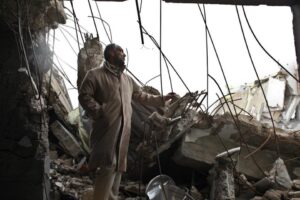
Mahmood Zarooq in his home in Sirte after a NATO airstrike in 2011. His wife was killed in the strike (Human Rights Watch/Sidney Kwiram)
After the war, allegations of civilians killed by NATO strikes also surfaced, with The New York Times, Human Rights Watch (HRW), Amnesty International and later the United Nations each conducting extensive on-the-ground research into the victims. Each report found that NATO took significant measures to avoid harming civilians, but identified a number of separate allegations of civilians killed.
Danish culpability was speculated on as early as 2011, with media in Copenhagen reporting that some key strikes were likely conducted by Danish pilots, but Danish authorities refused to comment.
Freedom of Information
In early 2021, Rasmus filed a Freedom of Information Request with the Danish Defence Command seeking “all communication regarding civilian casualties during the Air Force’s mission in Libya in 2011.”
A month later, an email appeared in his inbox. Attached were dozens of pages of internal reports never before seen by the Danish public. Why they had been declassified now was unclear – Rasmus, Joe and other reporters had similar requests rejected previously.
But as he flicked through, Rasmus knew he had a big story. The documents revealed for the first time that after the 2011 war, Denmark conducted a review of its involvement in strikes in which civilians had reportedly been harmed. While Danish officials had not conducted any ground research in Libya themselves, they had cross checked their strike list with all the allegations of civilian harm documented by HRW, Amnesty, the UN and others.
The review found that Danish planes dropped bombs in four strikes in which Libyan civilians were reportedly harmed.
It was completed in early 2012. Danish officials could have released the findings and offered routes to compensation and accountability for the victims’ families. Instead the documents were marked secret and classified – kept from the Danish population for more than a decade until they arrived in Rasmus’ inbox.
Marc Garlasco, who led the United Nations investigation into civilian victims from NATO strikes, said the documents “show that Denmark killed civilians and kept it secret from us.”
Tracking down the victims
Once Rasmus and Joe agreed to conduct a joint investigation, they had one immediate priority – searching for the victims’ families.
A quirk of modern international military coalitions is that while operations are conducted as a collective, civilian harm or compensation claims can often only be levelled at individual member nations. This was true with NATO in 2011, and it has been true with other campaigns since – such as the US-led Coalition against the so-called Islamic State in Iraq and Syria.
In almost all cases strikes are officially conducted by the coalition as a whole, with the individual member states not named. States argue this is necessary as it is a joint campaign so who pulls the trigger to drop any particular bomb is unimportant. Yet for the victims it feels like a Catch-22 – to seek accountability they must know which state carried out a strike, but coalitions say strikes are conducted collectively.
The documents released to Rasmus meant that, in these four instances, the victims’ families could have an answer to who harmed their loved ones – opening the door to accountability.
With support from the Journalismfund Europe, experienced Lebanese forensic investigator Maia Awada joined the team. Together, we conducted in-depth searches into the strikes over six months – trying to speak to each and every witness we could find to build out a fuller picture of the attacks.
Tower block flattened
In one of the four incidents, the report contained few details to investigate – with only the injury of one unnamed victim reported. As such, the team focused primarily on the other three.
The first one we investigated took place in Gaddafi’s home town Sirte, on September 16th 2011, a few weeks before the dictator’s death.
Both HRW and Amnesty visited the site after the strike and documented the bombing of a residential tower block. Pictures showed part of the block, known as the Al-Tameen Building, flattened.
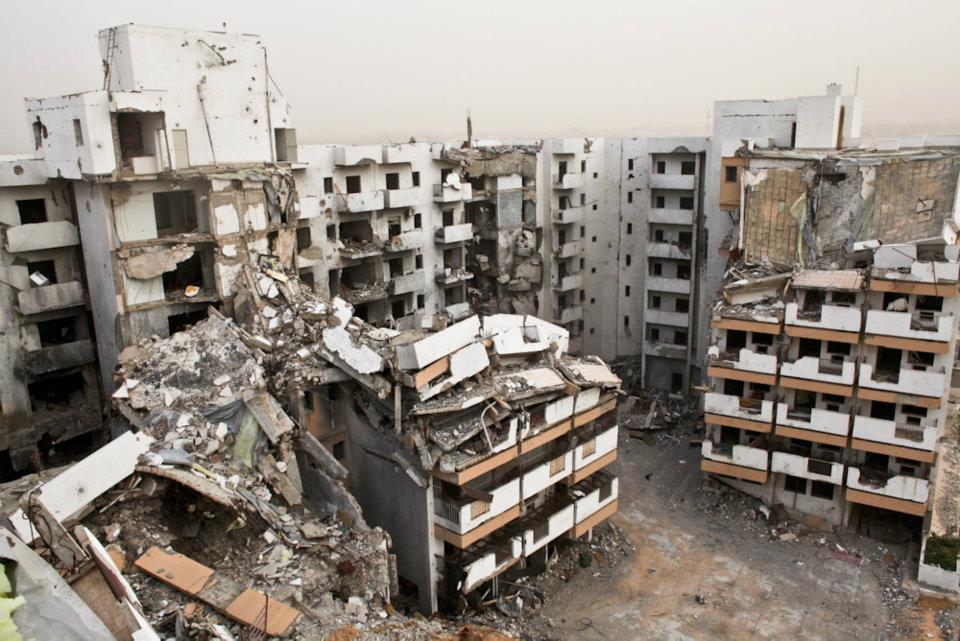
The Al-Tameen building in Sirte, Libya, after a NATO airstrike (Credit: Human Rights Watch/ Sidney Kwiram)
At least two civilians were killed, including Ayesha Bishir, a mother of two who was five months pregnant. Aisha’s husband Mahmoud described to HRW attack happened.
“All I can remember is that I flew into the air then I fell on my back. And it was dark. There was dust everywhere… I went back to search for [my wife] Ayesha and Rawasi. I kept calling them both and eventually Rawasi answered. Rawasi was under something metal. She was doubled over with metal and wood debris on her back. So I pushed away the debris and took her back to the room next to Tahani. And then I went back again to find Ayesha. I couldn’t find her.”
The documents showed that Denmark conducted the strike alongside one other nation, whose identity was redacted even in the declassified document.

A part of one of the documents released to Rasmus. It says: (Via International Committee of Inquiry on Libya (ICIL)) May 1 – attack that killed Gaddafi’s youngest son, Sayf al-Arab, his wife, and three children. Danish fighter jets carried out an attack on an ‘Alternate Command Center’ in Tripoli on the evening of April 30, and it is the assessment of FTK [The Air Tactical Command ed.] that there is conformity with the attack described by ICIL, even though they refer to the date May 1″
When told that it was Denmark, Faraj said his father had sought answers from the Libyan government and NATO for a decade. Yet even with the documents, he didn’t have much hope for accountability. “God will bring us justice,” he said resignedly.
The other civilian killed was Ali Omar Suwaysi, a young man whose family had left the building as the war came closer. Ali stayed behind with his brother Mustafa to guard the tower block.
Maia eventually tracked down Mustafa, who said Ali was upstairs in the family flat when the strike hit. Despite the heavy smoke, Mustafa rushed towards the stairs in a panic looking for his brother. A second strike hit and Mustafa was badly injured – spending 10 days in hospital.
Neither NATO nor Denmark have publicly commented on this strike. We interviewed all witnesses we could, seeking to understand the reason for hitting a residential tower block.
Ahmed Nouri, who lived in a nearby building, told us that before the attack, a radio station aligned to Libyan rebels reported the tower was being used by Gaddafi’s forces. “I remember they talked about weapons and snipers on the top of Al-Tameen Building,” Nouri recalled. The building was hit shortly after the radio report, he said, though he never saw anyone on top of the building.
Abduljalil Abdulatif lived in the tower with his wife and four children. He explained that most families had fled the area as Sirte became the front line. He added that before the attack, he visited the roof of the building and there were no snipers.
Sidney Kwiram, who visited the site for Human Rights Watch during the war, said she found more than a dozen spent small arms casings on the roof, but could not draw definitive conclusions when they were from. A few days earlier there had been clashes in the district between a local rebel family and Gaddafi supporters. The casings could have been from then, Kwiram said.
“A few witnesses I spoke to, including Mahmoud, told me that there were no snipers on the roof. A few others told me that Gaddafi snipers were on the roof around the time of the clashes to control the rebel supporters,” she said.
Kwiram said that during the war HRW visited one of NATO’s headquarters in Italy to discuss civilian casualties, and sought to understand which states conducted some strikes, including this one. “When we tried to have a conversation about that, we got nowhere,” she said.
Donatella Rovera, who investigated the strike for Amnesty International, said the organisation had been unable to get satisfactory answers from NATO about its intelligence. “Assuming that they received information that there was a military target in that building, what did they do to verify it?”
“Very often we see a situation where buildings are bombed based on intelligence that is not up to date at the time of the strike – there was a legitimate military target three hours or three days before the strike.”
Disinformation
A second incident, which was widely reported and featured in the UN Commission of Inquiry’s report, occurred on April 30, 2011 when one of Gaddafi’s residences was hit in the capital Tripoli, killing his son Saif al-Arab. Three of Gaddafi’s young grandchildren were also reported to have been killed. CNN later quoted the Libyan government naming them as Gartaj Hannibal Muammar al-Gaddafi, 3, Saif Mohammad al-Gaddafi, 2, and Mastoura Hamid Abuzitaia. Mastoura was reported to be the daughter of Gaddafi’s daughter Aisha.
The documents show that Danish planes conducted the strikes alone, calling the palace an “alternate command centre” for Gaddafi’s forces. This strike has proved controversial as it was alleged to have targeted Gaddafi – who was reportedly in the building. Critics argue that such targeting was not justified under the protection of civilians mandate. NATO denied targeting Gaddafi personally.

A part of one of the documents released to Rasmus. It says: (Via International Committee of Inquiry on Libya (ICIL)) May 1 – attack that killed Gaddafi’s youngest son, Sayf al-Arab, his wife, and three children. Danish fighter jets carried out an attack on an ‘Alternate Command Center’ in Tripoli on the evening of April 30, and it is the assessment of FTK [The Air Tactical Command ed.] that there is conformity with the attack described by ICIL, even though they refer to the date May 1″
After months of searching, we tracked down the French doctor named in reports as having verified the deaths. In a brief and tetchy call from his practice in southern France, he confirmed seeing the body of Gaddafi’s son but said he only saw one child-sized corpse with its face covered.
Aisha Gaddafi also filed a lawsuit against NATO for the death of her daughter. After several months her then lawyer, Luc Brossollet, agreed to talk. He said he was invited to Tripoli during the war and met Aisha briefly, when she asked him to take on the case. However he confirmed she did not provide significant documentation or evidence of the child’s death, including images or videos.
Overall, the evidence suggests that the victims may have been invented by the Gaddafi regime as part of propaganda to discredit the NATO bombing campaign. An in-depth article into this story will be published in the coming weeks.
Hamedi family
The final strike in the Danish documents involved Khweldi al-Hamedi, a well known Gaddafi loyalist. He had been a vital member of Gaddafi’s leadership team and later a senior military official, and was accused by Libyan rebels of benefiting from millions of dollars from the regime, claims his family denied.
Khweldi’s role in the 2011 war remains disputed. NATO claimed he was an active member of Gaddafi’s forces, but the family insist he retired a number of years before the war and was not involved.
On the night of June 20, 2011, his family home was struck. It was a large walled compound and again its purpose was contested. NATO claimed the site was a command and control node and the facility was “directly involved in coordinating systematic attacks on the Libyan people and was identified through rigorous analysis based on persistent intelligence, surveillance and reconnaissance.”
The family denied that the site was a military base and said it was home to Khweldi’s son Khaled and other family members. There is plenty of evidence the compound was at least partially used for residential purposes. Footage from a few days before the attack shows four young children playing in the garden.
What no one disputes is the devastating effect of the NATO attack.
In total 12 civilians were killed. Khaled, who was not home at the time, lost his wife Safaa, his daughter Khalida, 4, and son Khweldi, 3. His father Khweldi was unharmed and there were no reports of Gaddafi fighters killed.
The documents released to Rasmus showed that Denmark conducted the strike, along with one other partner whose name was redacted.
The case became particularly prominent when Khaled announced he would sue NATO in Belgium over the death of his family. We reached out to his appeals lawyer Jan Fermon. He explained that the case, which was originally filed in 2011, ultimately ended in 2017 when a Belgian court concluded NATO was immune from prosecution.
“If it wasn’t for the immunity I think we would have had a very strong case,” Fermon told us. “The immunity mainly put us in a position where the courts ultimately said ‘we don’t have jurisdiction, we can’t rule on this.'”
Fermon said that NATO’s structure – where strikes are officially conducted collectively but accountability must be sought from the specific country responsible – was a “mechanism to organise impunity.”
“You have no idea what member state [conducted the strike], so you have no option but to sue all the member states. That is, of course, an impossible situation.”
We hoped that Fermon would finally give us access to Khaled, but he said he had lost contact with him a number of years earlier.
Cairo
Seeking to speak to Khaled, we reached out to a range of contacts in Libya and the Middle East, including Mustafa Fetouri, a Libyan researcher who wrote a book in Arabic about the victims of NATO strikes in Libya.
After more than six months of searching, we finally were put in touch with Khaled’s brother Mohammed. He told us they would be happy to speak if we met them in Cairo. So in mid 2023, with Maia unavailable, Rasmus and Joe travelled to the Egyptian capital.
By the banks of the Nile, we sat planning what we would ask the man who had spent 10 years asking the same questions as we had – who killed his family.
Audio PlayerRasmus discusses the next day’s meeting with Khaled al-Hamedi
The next morning we drove out through Cairo’s crowded streets with our photographer Hamada, eventually pulling into a wealthy gated community. Ushered into a nondescript office block, at first it was slightly surreal.
Khaled started with a presentation – a video he had made interweaving images of his family before their deaths with footage from NATO’s press briefing about the attack. As he played a video of the NATO press conference, he paused multiple times to dispute the claims. He then handed us images of his children alongside pictures of civilians killed and injured in a booklet with the title “Message to the world: The Sorman Massacre in Libya”.
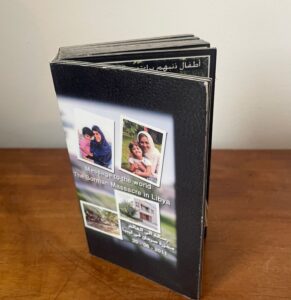
An image of a book produced by the Hamedi family entitled “Message to the world – The Sorman Massacre in Libya”
After slightly more than an hour, though, we went to a quiet restaurant and talked in more detail. Khaled talked through the legal cases and his frustrations – how he still hoped to get some answers.
Finally, around four hours after we arrived, Rasmus reached into his bag to present Khaled with a copy of the report with the words NATO SECRET etched along the top. He read it slowly.
After 12 years and seven months of trying to sue the military alliance, Khaled had an answer as to who dropped the bombs.
“So it was Denmark?” he said.
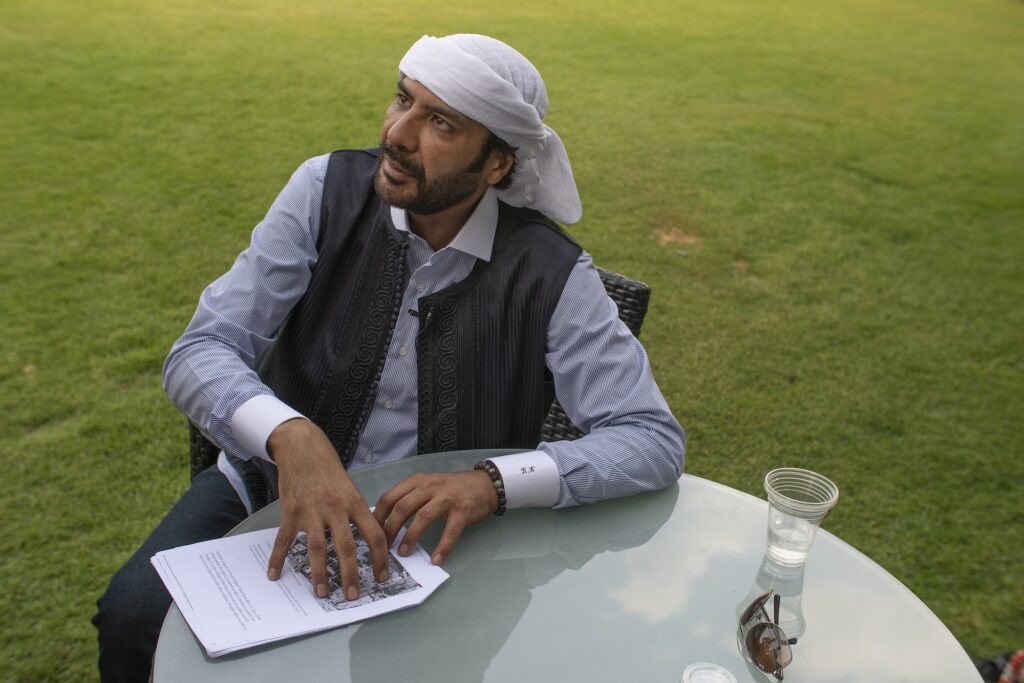
Khaled al-Hamedi reviews the document which shows Danish planes were involved in the strikes which killed his family (Hamada Elrasam/Airwars/Altinget 2023)
‘Lives could have been saved’
The release of the documents will have an impact in Copenhagen. Danish officials have already faced pressure to explain why this document was kept secret for so long, while Khaled has also said he may pursue a legal case in Denmark.
But the documents also put pressure on other NATO states to be more transparent. The review ruled out Danish involvement in a number of other attacks, such as notorious strikes in the town of Majer that killed at least 34 civilians. Those victims’ families are still waiting for answers.
Rovera, of Amnesty International, said it was “certainly not too late” for accountability but the anonymity of coalitions makes it harder. “If coalitions were more transparent with providing what members carried out specific strikes – which wouldn’t be sensitive – then that would be less of a problem,” she said. “For the purpose of accountability it would make a big difference, because we would have someone to engage.”
Garlasco, the former UN investigator, said the documents were “deeply significant” as they showed Denmark reflected on the civilian impact of its airstrikes. But he said the refusal to release it for a decade made it less “useful.”
“Useful not only for lessons learned so that lives could be saved in the future but also useful for the victims of these strikes – that they understand why their family members were killed and could potentially receive some kind of compensation for their loss.”
“How many civilians have died in wars after Libya because the lessons from the Danish report have not been learned?”
Annual report 2022
Airwars annual report for May 2022-May 2023.
The report outlines key highlights from the organisation’s research, investigations and advocacy departments over the time period, as well as strategic objectives and basic financial details.
It includes a foreword by Airwars’ director Emily Tripp, who took over at the beginning of the time period, and is designed to provide an overview of the how the different parts of the organisation overlap to achieve shared goals.
Annual report 2022
International gathering brings nearer a protocol on restricting explosive weapon use in urban areas.
States edged closer to a political declaration on the use of explosive weapons in populated areas on April 8th, after three days of crunch talks in Geneva.
More than 65 states descended on the Swiss city for key talks on the wording of a political declaration that advocates believe would save thousands of lives by restricting the use of wide area effect explosive weapons in populated areas (EWIPA). Detractors, such as the United States government, argue it would unfairly limit the freedom of their own military actions and have threatened not to sign.
While no final text was agreed upon Friday, all sides struck an optimistic tone at the end of the three-day meet – saying a deal was nearer than ever. Delegates will meet again for one day in two months before an adoption ceremony expected in the summer.
“There are clearly differences of opinion but we have seen a very positive, solution oriented approach,” the chairperson, Ambassador Michael Gaffey of Ireland, said. “We are not simply working on a formula of words in a political declaration – we want to make a real difference and impact on the ground and foster behavioural change.”
The talks were given additional urgency by the ongoing war in Ukraine, and Russia’s extensive use of explosive weapons on its cities. Moscow did not attend the talks.
Even the United States, widely viewed as one of the most hostile states to a declaration with teeth, struck a more positive tone than in previous meets. “There are still tough drafting issues and decisions ahead, and we have to get them right. The US delegation pledges our goodwill, to help to get to a positive outcome. We look forward to doing so.”
Since 2018, Ireland has chaired consultations on the use of explosive weapons in populated areas. In the sessions since, the need for such a declaration – which is not legally binding and so does not create new legal obligations – has only become clearer.
“The draft declaration text holds the potential to make a meaningful contribution to the protection of civilians, and negotiations over the past few days have overall been constructive,” Laura Boillot of INEW, a network of NGOs pushing for the protocol, told Airwars.
“But decisions will now need to be made if the final text is going to have humanitarian effect. Most importantly it needs to establish a presumption against the use of explosive weapons with wide area effects in towns, cities and other populated areas.”
It will be a failure to leave this room agreeing that simply restating existing laws will reduce civilian harm – a failure for all of us who came here with the intention to reduce that harm in the first place." @alma_osta in HI concluding remarks at #EWIPA negotiations today. pic.twitter.com/pTKpgfqWWU
— HI_Advocacy (@HI_Advocacy) April 8, 2022
Civil society groups and international agencies made a strong case for restricting EWIPA.
Three days of consultations
During three days of focused talks, several key fissures bubbled. While states in attendance – and civil society organisations – repeatedly emphasised the shared desire to produce a tangible and meaningful political declaration that could help save civilian lives on the ground, the practicalities of the process made clear that good intentions weren’t going to be enough.
On the first day of the informal consultations on April 6th, states made general remarks – affirming their support for the proceedings as well as their national positions – after an introductory statement from Ireland, the penholder.
In these general remarks, most states tended towards re-affirming the positions they had made clear in previous negotiations. On the hawkish side, the UK, US, Israel and Canada all emphasized that their positions as militarily active states meant that they would not sign a declaration in its current form, which included strong language about avoiding the use of explosive weapons in urban areas. Throughout the week, the delegates from these countries could often be seen meeting as a bloc outside of formal proceedings.
Many of the sticking points that emerged on the first day continued to dominate both the main floor and side conversations. The predominant line of argument was between those who argued that the declaration needed only to reaffirm the importance of international humanitarian law and provide further guidance about how to do so in this context; and those who asserted that this declaration needed to strengthen existing commitments and add new ones for states around the use of explosive weapons.
The second day of discussions took a more technical turn, with the majority of interventions focused on the wording of specific clauses and paragraphs of the text.
Clause 3.3, which attracted much attention in previous consultations, was once again hotly debated. It is one of the first clauses in Section B, the operative section – which lays out the actions that states have to comply with if they choose to sign onto the declaration.
In the current draft, Clause 3.3 says states must: “Ensure that our armed forces adopt and implement a range of policies and practices to avoid civilian harm, including by restricting or refraining from the use of explosive weapons with wide area effects in populated areas, when the effects may be expected to extend beyond a military objective.”
The bulk of the discussion around this clause was on the second sentence, as many states intervened on the use of “restricting or refraining,” with some suggesting it was strong enough while others lobbied instead for the use of “avoid”.
A split between the majority of civil society organisations and militarily-powerful states was apparent during these parts of the discussions, with NGOs and international agencies pushing for stronger language, rather than trying to place limits on what kinds of civilian harm would be protected under this new declaration.
Airwars’ incoming director and current head of research Emily Tripp also made an intervention – emphasising how crucial it was for states to actually track civilian harm.
Airwars’ incoming director Emily Tripp addresses a UN-backed conference on explosive weapons in Geneva on April 7th, 2022 (Image: Airwars)
At the end of day two INEW, one of the organisers, named nine states – Belgium, Canada, Denmark, Israel, the Republic of Korea, Sweden, Turkey, the United Kingdom and the United States – that it said had “worked to weaken declaration provisions.” The UK delegation, for example, agreed that tracking civilian harm was a ‘moral obligation,’ but then highlighted ways in which it claimed this was not feasible – arguing that live hostilities made it near impossible to monitor casualties properly.
But INEW also said that there had been a “shift in the collective tone set by states since the last round of negotiations, with more governments explicitly committed to strengthening the protection of civilians through the declaration.”
The statement said this was likely as a response to the bombing of Ukrainian towns and cities, and the Ukraine crisis loomed large over the conflict. Not only did the majority of states open their remarks with condemnation of the Russian aggression in Ukraine, many also emphasised the importance of a meaningful political declaration with specific reference to Ukrainian cities and towns such as Mariupol, Bucha and Khrarkiv.
There was also an emphasis on the value of protecting civilian objects and infrastructure, such as schools and hospitals, with states such as Mexico and the delegate for the Holy See (which holds observer state) urging specific language around the need to protect hospitals, blood transfusion centres, and environmental and religious sites.
Speaking at the end of the latest talks, Ambassador Gaffey said Ireland and organisers would review the submissions from all parties before a month or two of further work on the text. He said states and NGOs would then hold a final one-day consultation in a couple of months, before a political adoption ceremony where states would declare their support for the text.
As Alma Taslidžan Al-Osta, of Humanity and Inclusion, noted in her own concluding remarks to delegates: “Eleven years in Syria, seven years in Yemen and over a month in Ukraine have taught us that explosive weapons with wide area effects should not be used in towns, cities and populated areas. The status quo is no longer an option.”
Civilians increasingly bear the brunt of modern conflicts. Addressing the devastating harm to civilians from Explosive Weapons in Populated Areas is a priority for 🇮🇪. We welcome states, international organisations and civil society to consultations in Geneva this week #EWIPA pic.twitter.com/pAyglwZO9D
— Disarmament IRELAND (@DisarmamentIRL) April 6, 2022
Ireland chaired Geneva talks on restricting urban use of explosive weapons
Crunch talks in Geneva aim to hammer out protocol on explosive weapons in urban areas
The shadow of the Ukraine conflict loomed large over the first day of the informal UN-backed consultations on a political declaration on restricting the use of wide area effect explosive weapons in populated areas (EWIPA), currently underway in Geneva.
Delegates from more than 65 nations have gathered to fine tune the language of the political declaration, along with more than 15 civil society organisations including Airwars. The chairperson, Michael Gaffey of Ireland, opened the proceedings by calling for a minute of silence for Ukraine.
Nujeen Mustafa, who had fled the war in Aleppo, then powerfully testified via a video message, saying, “throughout history, diplomats have discussed world problems while sitting at a table with a nice coffee. People trapped in a conflict zone cannot do that. Today, you have the possibility to change a terrible situation and protect civilians.”
Nujeen Mustafa, a Syrian who fled Aleppo after it was largely destroyed by explosive weapons, addresses delegates:“While you’ve been negotiating whether a declaration should be made, 11,076 people have fallen victim to these weapons" she sayshttps://t.co/DI9vYhD6nq
— Airwars (@airwars) April 6, 2022
While there are two days of discussion left before proceedings close on Friday evening, many of the most pressing issues arose in proceedings on Wednesday – particularly as states laid out their own positions during opening remarks. Here are five key themes from the first day of EWIPA negotiations.
1. The conflict in Ukraine adds a sense of urgency
The first statement was made by the Ukrainian delegate, who noted that “our cities and towns have been turned into dead ash because of the use of these explosive weapons” – highlighting a new sense of urgency and relevance which the negotiations have taken on.
Every delegate who spoke made reference to the Ukraine conflict, with many emphasising that the violent and horrific violence against Ukrainian civilians must move states to act more effectively. The French delegate noted that Russia did not attend the proceedings, while the Japanese delegation emphasised the importance of documenting civilian harm in Ukraine.
Many other states called on Russia to cease its aggression and indiscriminate bombing of civilians and it was noted multiple times that Russia’s campaign has targeted and destroyed civilian neighbourhoods using wide area effect explosive weapons – referring to the scenes of destruction in Kherson, Mariupol, and Kharkiv.
2. The gap between ‘IHL is enough’ and ‘IHL does not go far enough’
Broadly the delegates and countries fall into two groups – those that believe international humanitarian law (IHL) is enough to protect civilians under attack in urban areas – and those that argue more is needed to protect civilians.
States such as the USA, UK, France and Israel argued that any political declaration could not introduce new legal requirements (which it cannot) and that the requirements currently set out under IHL should be sufficient protection for civilians. Currently, these frameworks emphasise for example that deliberately attacking civilians and civilian infrastructure constitutes a violation of IHL – and that any military actions must be both proportionate, and distinguish between civilians and combatants.
Those backing strong wording to the political declaration text – from Ireland to the ICRC – insist that adherence to IHL alone is not doing enough to protect civilians during much urban fighting.
The US nevertheless called on those states gathered not to produce an “unrealistic impression” that civilians would not be harmed in conflict, while emphasising that explosive weapons are “considered a legitimate and lawful means of warfare when used in accordance with IHL.”
But other states, as well as civil society organisations such as Human Rights Watch, emphasised that any resolution which merely restated the value of IHL – and how states must abide by it – would effectively be useless, as it would be an iteration of what states have already committed to.
States such as Finland and Sweden remarked that there are gaps within IHL around EWIPA , and mere compliance with IHL is not enough to protect civilians. This has been an ongoing fissure during previous consultations, and continues to be a major fault line.
3. Reverberating effects
The particularities of the language used in the eventual political declaration are at the heart of the ongoing consultations in Geneva – with discussions about whether to “avoid” or “restrict” the use of explosive weapons in populated areas already a key sticking point.
An additional area of tension appears to the so-called “reverberating effects” of EWIPA, which are essentially the long-term effects.
An example of a reverberating effect would be the destruction of a bridge. If destroyed, it has the immediate effect of removing a crucial piece of civilian infrastructure. But even after the conflict finishes the destruction could also mean that people can’t travel across a certain river, making it harder to access other kinds of civilian infrastructure such as hospitals or schools.
These long-term impacts were the subject of much discussion on Wednesday – with some states, such as the US, Israel, and the UK all noting that ‘reverberating effects’ is neither a legal term nor – they claimed – a widely accepted term with a clear definition. The US also said it would not accept a ‘novel’ term such as reverberating effects in the eventual political declaration.
However, civil society organisations such as PAX and observer states such as the Vatican suggested that it would be difficult to meaningfully understand the full implications of how civilian populations were impacted without incorporating ‘reverberating’ effects.
4. Focus on the humanitarian impacts
The Holy See opened its own remarks by noting that it believes conventional weapons should be named “weapons of mass displacement,” a nod to the ongoing long term effects that explosive weapons can have. The Danish Refugee Council also noted that the use of EWIPA can contribute to displacement, and in time, continuously produce forms of renewed displacement.
Some other states such as Uruguay emphasised the need to collect and monitor the impacts of EWIPA on specific groups – such as those with disabilities, or those who face discrimination because of their gender. Organisations such as CIVIC, PAX and Humanity and Inclusion also spoke about the psychological and mental effects of the use of explosive weapons, notably the need for a survivor-centric approach to any kind of political declaration.
5. The impact of non-state actors
While the political declaration is primarily a matter between states, the UK, Israel, the US and others asked that the considerations around EWIPA must also extend to non-state actors, such as armed groups, in the interest of maintaining what they termed a balanced account of how explosive weapons are actually used in populated areas.
The US noted for example that “the declaration has to make it clear that all belligerents, including non-state armed groups, must take steps to address the harms to civilians and civilian objects.” The Turkish delegation argued that asking non-state actors to really consider these impacts would also mean they would be considered as legitimate parties to an international armed conflict – which they are currently, for the most part, not.
The declaration has to make it clear that all belligerents, including non state armed groups, must take steps to address the harms to civilians and civilian objects,” says the USA, intervening for the second time today. pic.twitter.com/cNBYvzncqN
— Airwars (@airwars) April 6, 2022
Civilian harm reduction proposals cautiously welcomed by NGOs - but delivery will be key.
Secretary of Defense Lloyd Austin has announced major proposals to overhaul how the US military monitors, assesses and documents when its actions kill civilians, a move warily welcomed by human rights and civilian harm mitigation NGOs.
Building on years of documentation by groups like the Syrian Network for Human Rights and Airwars, since late 2021 the New York Times has produced a series of deep investigations documenting systemic flaws in the way US military operations track casualties from their strikes. These revelations have prompted further scrutiny of the US military’s approach to civilian harm and raised pressures on the Biden administration to intervene.
In a directive released on January 27th, Austin announced a major shake-up of Department of Defense (DoD) policies on civilian harm reduction, including the establishment of a ‘civilian protection center of excellence’.
“The protection of innocent civilians in the conduct of our operations remains vital to the ultimate success of our operations and as a significant strategic and moral imperative,” Austin told reporters.
The directive gives the Under Secretary of Defense for Policy, Dr Colin Kahl, 90 days to prepare a “comprehensive” Civilian Harm Mitigation and Response Action Plan, or CHMRAP, that emphasises that “efforts to protect civilians are the responsibility of all leaders throughout the (DoD), always, and not only that of our commanders and personnel in the field in the execution of missions assigned.”
Austin’s directive also paves the way for the establishment of a new ‘civilian protection center of excellence’ which according to DoD, will enable it to “better expedite and institutionalize the advancement of our knowledge, practices, and tools for preventing, mitigating, and responding to civilian harm.”
And there are also plans to shake up how the Pentagon collects, shares and learns from casualty data; to re-examine the issue of condolence payments to victims; and to “Incorporate guidance for addressing civilian harm across the full spectrum of armed conflict into doctrine and operational plans, so that we are prepared to mitigate and respond to civilian harm in any future fight.”
The CHMRAP will then itself feed into a forthcoming Department of Defense Instruction, or DODI – a long awaited department-wide policy on civilian harm reduction. Airwars was among more than a dozen US and international NGOs which engaged extensively with the Pentagon on the DODI – which has been awaiting a signature since November 2020, when drafting was completed.
According to Austin, the DODI “should be informed by the CHMRAP and presented to the Secretary of Defense for signature within 90 days of the CHMRAP’s conclusion” – meaning it should come into force by late July.
“Austin’s directive and the promised release of the DODI could be a crucial step towards standardising the US military’s approach to civilian harm assessments across US commands,” Emily Tripp, Airwars’ research manager, said.
Marc Garlasco, a military advisor at PAX and former civilian harm assessor with NATO, was among those cautiously welcoming the Pentagon announcements. “The memo sends a strong message that civilian harm mitigation (CHM) is not simply an issue for counterinsurgency. The US military is embracing CHM as it shifts to great power competition,” he said in a thread on Twitter.
🧵 on today's memo on "Improving Civilian Harm Mitigation & Response" by @SecDef. The memo is welcome focus from the highest level of @DeptofDefense showing leadership & taking ownership of the issue of civilian harm. Allow me to cover the salient points both pro & con 1/ #CIVCAS https://t.co/BJ83W6mXX9
— Marc Garlasco (@marcgarlasco) January 28, 2022
Critical study
On the same day that Secretary Austin announced his shakeup, the RAND Corporation also published a major Congressionally-mandated review of the US military’s approaches to mitigating civilian harm.
The deep-dive report, ‘US Department of Defense Civilian Casualty Policies and Procedures,’ argues that while the DoD may have made progress in some areas, “additional concrete steps are overdue.”
RAND points to several weaknesses in the DoD’s own policies and procedures – including that military officials often did not “sufficiently engage external sources” such as Airwars before they concluded investigations and designated them as non-credible; that investigations are often treated as independent of each other and so levels of detail between them vary widely; and that military assessments are often subject to long delays.
Several graphics in the report demonstrate the often extreme gap between US military estimates of civilian harm, and those of NGOs such as Amnesty International, Human Rights Watch and Airwars – noting that in Syria in 2019, more than 1,100 civilian deaths were locally alleged from US actions, yet with only 21 fatalities so far officially admitted.
The RAND report makes a number of recommendations, noting that many were called for several years ago. These include incorporating civilian harm assessments into intelligence estimates; reducing the eligibility conditions for those who can claim ex gratia payments; and implementing a standardised civilian harm reporting process across conflicts.
Airwars was among several stakeholders which met with RAND during the drafting of the report. “Many of the critical recommendations in this valuable study have long been requested by the NGO community and by Congress – and we urge the Biden Administration to now act swiftly,” Airwars director Chris Woods said.
The alliance bombing campaign had a devastating toll—but, a decade after the war, leaders have still not taken responsibility.
This article was written by Airwars’ senior investigator for Foreign Policy. It can be read in full here.
Attia al-Juwaili may never know which country’s laser-guided bomb killed his young daughter. It could be a British, French, or American pilot who struck, but until he finds out, his family’s hopes for justice are forever on hold.
It has been 10 years since the NATO-led coalition dropped the first bombs targeting Libyan strongman Muammar al-Qaddafi’s forces—turning the tide in Libya’s civil war and playing a critical role in bringing down the dictator. The merits of that intervention have been long debated, with foreign meddlers and local rivals and extremists thriving in the vacuum ever since.
But there was a more direct cost. In a war fought expressly to protect civilians, NATO’s airstrikes inadvertently killed dozens. New research by the civilian casualty monitoring watchdog Airwars, where I am the senior investigator, lays out for the first time the estimated number of civilians killed by all parties to the 2011 war—including both Qaddafi forces and Libyan rebels. Almost none of the families left behind have received compensation or an apology.
While NATO insists it took steps to avoid killing civilians, when there were casualty allegations it had limited mechanisms to assess on the ground, with one former official saying they “really had no idea.”
And those seeking an apology have instead found themselves trapped in a nightmare in which NATO itself does not make condolence payments but insists accountability must be sought from individual nations. Yet, even a decade on, countries including the United Kingdom, France, and the United States still refuse to accept public responsibility for any harm they caused.
Juwaili’s family and a few others had sought refuge in the village of Majer in northern Libya a few weeks before the deadly strike, after fleeing the encroaching ground war between Qaddafi’s forces and NATO-backed rebels.
It was Ramadan, so prayers lasted late into the evening. Afterward, the women and children went inside, while the men sat in the August heat chatting.
“Then everything was black, we couldn’t see anything. After the smoke subsided it was clear the second floor was destroyed,” Juwaili told Foreign Policy.
The men rushed forward, searching through the rubble for survivors. Fifteen minutes later, another strike killed many of the rescuers.
Juwaili hunted frantically for his 2-year-old daughter, Arwa, eventually finding her lifeless under the rubble. “Thank God her body was not ripped apart,” he said.
The United Nations later concluded 34 civilians died at Majer that night, including Arwa. NATO called the site a command and control node for Qaddafi’s forces. The residents denied this, and U.N. investigators found no evidence of military activity.
“My message to NATO is that yes, mistakes happen, but you need to correct such mistakes,” Juwaili said. “I feel that we were treated as if we were nothing and they did not look back. I hope when Libya is back on its feet, we get justice.”
Read the full story on Foreign Policy here.
NATO members still refuse to discuss potential civilian harm from their strikes a decade after intervening against Gaddafi.
Ten years ago, French President Nicholas Sarkozy welcomed British Prime Minister David Cameron and US Secretary of State Hillary Clinton to the Elysee Palace with a shock announcement. “He surprised us both when he said that he had already issued orders for French jets to take off,” Cameron later recalled. The first airstrikes of the international intervention against Libyan dictator Muammar Gaddafi’s forces hit their targets less than an hour later.
The 2011 Libyan civil war had begun on February 17th as an Arab Spring uprising, with tens of thousands taking to the streets. Within weeks Gaddafi’s forces had brutally crushed most of the protests, and were closing in on the last major rebel stronghold of Benghazi. With fears of a Srebrenica-style massacre, the United Nations passed a resolution demanding the protection of civilians, upon which the NATO intervention was then justified. The war officially ended in October as Gaddafi, whose forces had been routed, was captured and killed by NATO-backed rebels.
Neither during nor after the war has there been a thorough analysis of the number of civilians likely killed by all sides. For the tenth anniversary of the conflict, Airwars has conducted the first comprehensive overview of civilian harm from all belligerents, based on the available public materials.
Over six months Airwars reviewed thousands of media and social media posts, and post-conflict investigations; as well as conducting interviews with survivors and officials.
The result is a detailed look at a brief but violent conflict that killed at least 1,142 civilians and injured at least one thousand more in 212 incidents of concern that Airwars researched. By the highest estimate, as many as 3,400 civilians were killed in those events.
The new archive offers a detailed insight into gruesome air and artillery strikes, as well as shocking ground massacres that occurred during the civil war. The tally of civilian deaths during the uprising was almost certainly significantly higher than the Airwars study indicates. In 2011 for example, social media use by Libyans was still relatively limited, and independent media in the country was not yet established. Based on Airwars’ experience of other conflicts such as Syria, a significant number of local claims of civilian harm made online at the time may also since have been lost, as a result of sites being closed or accounts being shut down.
Many small scale ground actions are additionally not reflected at present in the Airwars database – though likely constituted a key element of the civilian toll. Most estimates of Libya 2011 casualties to date have included both fighters and civilians – with a Libyan government study from 2013 likely being the most accurate, with its estimate of 4,700 fighter and civilian deaths on the rebel side alone, as well as at least 2,100 people listed at the time as missing.
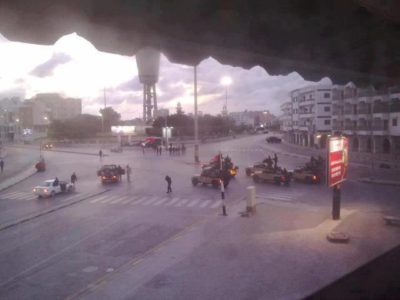
Armed men at the edge of Fashlum Al-Dhahra neighbourhood in Tripoli on February 20th 2011, where up to 700 civilians were alleged killed by Gaddafi forces while taking part in mass demonstrations, Image via Taha Krewi
Most deaths from Gaddafi forces
The tragedy of Libya’s 2011 war was not just of those who were killed, injured and displaced – but of the new world it ushered in. Following a couple of years of uneasy calm, by 2014 the country had split in two and reverted to civil war. Only in October 2020 was a United Nations-brokered deal seemingly able to bring a decade of violence to an end, though the rifts remain.
Hala Bugaighis, a Libyan lawyer and founder of the Jusoor Libya think tank, said the 2011 war has had two long-lasting effects that have deeply impacted Libyan society.
“The first is the impact on the social fabric that emerged from armed conflicts between cities,” she told Airwars. During the war some neighbouring towns found themselves on either side of the conflict, with one broadly loyal to Gaddafi’s forces and the other supporting the rebellion.
“The second is the long term effect of the conflict on the mental wellbeing of civilians, including PTSD, stress and depression,” Bugaighis added.
The majority of civilian harm identified in the events reviewed by Airwars was reportedly caused by forces of the Gaddafi regime – with between 869 and 1,999 likely deaths and as many as 1,100 injuries identified from 105 assessed actions. Overall, as many as 2,300 civilian deaths were locally alleged from these same Gaddafi actions. Many more small-scale killings have yet to be fully documented.
At the beginning of the uprising, Gaddafi forces were reported to have deliberately targeted protesters with both heavy weaponry and small arms fire, causing high numbers of casualties.
Later on, several massacres and indiscriminate shelling of urban areas by the regime were documented in both local and international media.
“In the first days of the uprising, I was so scared,” said Bugaighis, who lived in Tripoli at the time. “Growing up in Libya we were raised to fear the regime, so at first, I thought nothing would take down the regime. I started to realise that it is more serious when the state of emergency was declared in Tripoli and foreigners were evacuated.”
Many Gaddafi forces incidents had previously gone unreported to an international audience, given the tendency of international media to focus only on larger scale events. On June 29th for example, a review of local sources found that a 13-year old boy named Moftah Muhammad Jalwal was killed and six more civilians injured by Gaddafi forces shelling on the Doufan neighbourhood of Misurata. Gruesome videos showed bloodstains at the site and injured children in the local hospital.
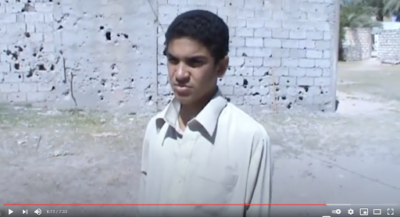
Moftah Muhammad Jalwal, reportedly killed by Gaddafi forces on June 29th 2011 in Misurata (Screengrab via a video by Ali Al Dadi)
NATO: lower civilian harm but lack of accountability
A decade on from NATO’s intervention, neither it nor any individual member has ever publicly admitted to a single civilian death. Libyans themselves tell a very different story.
Airwars reviewed claims of thousands of airstrikes reportedly conducted by NATO and its allies during Libya 2011, which between them resulted in 223 to 403 likely civilian deaths and 215 to 357 injuries in 84 events of concern, according to our assessment. NATO itself declared having conducted 7,600 strikes. Overall, Airwars identified as many as 800 civilians locally alleged killed by NATO forces – though those higher claims appear to have been significantly exaggerated by pro-Gaddafi sources at the time.
United Nations investigators after the war accused both Gaddafi and rebel forces of indiscriminate killings, but concluded that NATO had conducted a “highly precise campaign with a demonstrable determination to avoid civilian casualties.” They noted that the international alliance had used precision-guided munitions and carried out extensive pre-strike assessments to try and avoid killing civilians.
Frederic Wehrey, Senior Fellow at the Carnegie Endowment, said NATO planners were supported by Western special forces marking targets on the ground, which had contributed to the accuracy of bombing and helped avoid civilian harm.
Both rebels and NATO were “very active in liaison, coordinating various operation centres even though NATO commandos made clear they were not acting as the rebels’ air force,” he says.
But while NATO itself insisted it was purely focused on protecting civilians, key members of the alliance were accused of supporting regime change. An Airwars investigation has found that a Norwegian effort to negotiate Gaddafi’s stepping down in April 2011 was seemingly undermined by France and the UK. As the former Norwegian Foreign Minister Jonas Store now notes, “Had there been in the international community a willingness to pursue this track with some authority and dedication, I believe there could have been an opening to achieve a less dramatic outcome and avoid the collapse of the Libyan state.”
Even though the number of reported civilian casualties from NATO actions is far lower when compared to Gaddafi forces, Airwars’ findings indicate that likely fatalities were still significantly higher than the estimated 60 deaths that the United Nations documented at the time, in its review of 20 events of concern.
By contrast and based on local reporting from the time across Libya, as well as major investigations by Human Rights Watch, Amnesty International and the New York Times, Airwars has identified at least 223 likely civilian deaths.
Those seeking clarity about individual incidents remain sadly disappointed. Inquiries to NATO about civilian harm from its actions in Libya are routinely referred to member states, which in turn then refer back to NATO. All recent Freedom of Information requests from Airwars to individual member states about their potential role in civilian harm during 2011 have been denied.
Only on one known occasion, on June 19th 2011, did NATO acknowledge that a malfunction of a munition in an attack on Tripoli’s Souk al Joumaa neighbourhood had potentially resulted in civilian casualties.
Mohammed Al Gharari, who lost five family members in the strike, told Airwars he had the following questions for NATO: “You struck people and admitted that it was by mistake. Why did you never care about us? If you had any humanity and you believe in human rights, you would have at least cared.”
“Even after ten years, no phone call or even any official has contacted us.”
Aftermath of the incident in Souq Al Joumaa on June 19th, 2011
Little reporting on civilian harm from rebels
Among the three parties to Libya’s 2011 war, the lowest documented number of civilian casualties was reported from rebel actions – with 57 incidents of concern reviewed by Airwars containing allegations of between 50 and 113 likely deaths.
That relatively low estimate of civilian harm from rebel actions can be explained by the lack of an air force and access to heavy weapons, particularly early on. It may also reflect a lack of media interest at the time.
The largest known loss of civilian life from rebel actions was reported on August 10th in the remote southern city of Tawergha, when between 24 and 74 inhabitants, including whole families and an imam of the town, were claimed killed by artillery fire. Tawergha was considered loyal to Gaddafi, with its more than 40,000 residents forced to flee by rebels. The majority of residents have still not been able to return a decade on.
“130 men from Tawergha are missing ever since, and no one knows anything about them. They were taken by the rebels. My brother is one of them,” Gabriel Farag, who also had to flee Tawergha, told Airwars. “These 130 men were arrested just for the mere fact that they are from Tawergha.”
“The war has impacted Libyan society in many ways, especially in social relationships among tribes. Libyan society is a tribal society, and the war has broken the connections between tribes across the country,” says Mustafa Al Fetouri, a Libyan journalist who covered the civil war back in 2011.
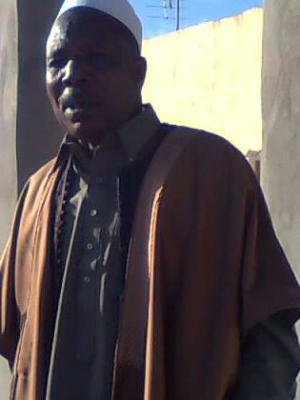
Mabrouk Elyan, reportedly among those killed by rebel forces on August 10th 2011 in Tawergha, via Tawergha Martyrs
Ten years of anarchy
What followed after the 2011 defeat of Gaddafi was a decade of chaos and on-and-off civil war that turned Libya into a failed state. Many hopes were betrayed and opportunities missed in a country that had once been described as Africa’s most developed.
“The notion of justice was completely absent after the revolution,” says Bughaigis. “Instead of avoiding a repetition of the injustice that occurred in the past, such as the Abu Salim prison incident or the killing of students, all we saw was the repetition of these mistakes over and over again.”
Airwars found that some victims had been paid compensation by one of Libya’s post-revolution governments, but only for damage done to property. Efforts to create proper mechanisms for restitution were abandoned when the country slipped into civil war again in 2014.
“Justice was one of the principles of the Libyan uprising. However, all those in power have failed to do so, and it may be in a systematic way to entrench chaos and hate,” explained Bughaigis.
Former US President Barack Obama once described the failure to plan for what came after NATO’s intervention in Libya as a “shit show”, and as his biggest foreign policy mistake. “We averted large-scale civilian casualties, we prevented what almost surely would have been a prolonged and bloody civil conflict. And despite all that, Libya is a mess,” he told The Atlantic in 2016.
However, better times could now be ahead for Libyans, with the country recently selecting a unified transitional government which has committed to working on a reconciliation process for those affected by the civil wars. Those in the international community who have become embroiled in Libya’s violence since 2011 could now too – it might be hoped – finally acknowledge the civilian harm they themselves have caused.
Out with the old, in with the new.
Family photo of Libya’s outgoing Presidency Council today after they handed over power to new unity government represented here by prime minister Dabaiba & new Presidency Council president Mnefi (front right and left) pic.twitter.com/Zgq36LCFde
— Mary Fitzgerald (@MaryFitzger) March 16, 2021
Incident date
March 18, 2011
LOCATION
مصراتة, Misurata, Misrata, LibyaOne man was allegedly injured by a NATO airstrike while travelling in his car in Misurata. Surt son posted two videos on Youtube of the young man telling his story how he was hit. In the videos he appears severely injured and burned. There is currently no further information available.
Summary
Incident date
November 1, 2011
LOCATION
مزرعة الأبحاث, Research Farm, Surt, LibyaOne child was allegedly killed and his uncle injured by a NATO airstrike on a research farm near Sirte. Nour Al Din Nasser Al Zanki said: “Abd al-Hadi Hamad Abd al-Rahman Qazwari, the son of an 8-year-old, was struck by a warplane on the research farm and his uncle lost his legs.” NATO did not
Summary
Incident date
March 18, 2011
LOCATION
منطقة العمارات, Al Amarat, Surt, LibyaOne child was allegedly killed and its mother injured by a NATO airstrike on Sirte. Nour Al Din Al Zaki said: “Siham Mohammed al-Qantari, 24 years. She was hit by shrapnel in the back which caused paralysis and is now under treatment and her child die who was in her lap next to her house
Summary
Incident date
October 19, 2011
LOCATION
سرت, Sirte, Surt, LibyaSix civilians, including one child, were allegedly killed by a NATO airstrike on Sirte. Libya Now said: “Yesterday, Saturday, the revolutionaries found in the city of Sirte a cemetery containing the remains of 6 people from one family, including a child, who were killed by the bombing of the second area at dawn last Wednesday.”
Summary
Incident date
October 6, 2011
LOCATION
الدولار, Dollar , Surt, LibyaThree civilians were allegedly killed and a mother injured by a NATO airstrike on the Al Wafa neighbourhood of Sirte, which is alternatively referred to as Al Dollar neighbourhood.. ANVWL said on one of the victim’s circumstances of death on October 6th: “The child was killed in Al-Wafa neighbourhood, Al-Dollar neighbourhood, as a result of
Summary
Incident date
October 5, 2011
LOCATION
سرت, Sirte, Surt, LibyaA Sudanese family of seven was allegedly killed by a NATO airstrike on Sirte. Al Jamahiriya reported: “A Sudanese family of 7 was martyred in Sirte, as a result of the bombing of their house by NATO mercenaries and its agents.” Other sources published carbon copies of the story. NATO did not report strikes near
Summary
Incident date
October 3, 2011
LOCATION
قصر أبو هادي, Qasr Abu Hadi, Surt, LibyaOne child was allegedly killed by a NATO airstrike on Qasr Abu Hadi. Al Gaddadifa martyrs said: “Child martyr Muammar Khalaf Allah Misbah Al-Amouri Gaddafi killed as a result of indiscriminate shelling of NATO gangs.” Other sources also reported his death. NATO did not declare any strikes in the area on that day.
Summary
Incident date
October 3, 2011
LOCATION
قصر أبو هادي, Qasr Abu Hadi, Surt, LibyaOne child was allegedly killed by a NATO airstrike on Qasr Abu Hadi. Three different pages listing victim of the NATO intervention named Muhammad Khaled Al-Sayyid Al-Qahsi Al-Gaddafi as killed on October 3rd. A comment on the Al Gaddadifa page said he was “killed in front of his family’s eyes on 3/10/2011 at 3 o’clock
Summary
Incident date
October 2, 2011
LOCATION
سرت, Sirte, Surt, LibyaA single source reported that one child was critically injured by an attack by NATO and was being treated at a hospital in Sirte in October 2nd, 2011. NATO on that day reported hitting “1 multiple rocket launcher, 1 armed vehicle” in the vicinity of Sirte. There is no further information currently available.
Summary
Incident date
October 2, 2011
LOCATION
مسجد الفرقان, Al Furqan mosque, Surt, LibyaDuring Isha prayers in the evening prayers, an indiscriminate attack was launched on Al Furqan Mosque by NATO, resulted in several injures to worshipers who later were moved to Ibn Sina Hospital in Sirte, in the second of October 2011. A source affiliated with Gaddafi, against the day 17 in Libya, claims that due to
Summary
Incident date
October 1, 2011
LOCATION
1000 وحدة سكنية, 1000 Housing Project, Surt, LibyaOne civilian was allegedly killed by a NATO airstrike on the 1,000 housing units in Sirte. According to Al Gadadiffa martyrs, “Yaza Omar, age unknown, was killed due to the indiscriminate shelling of 1,000 housing units.” NATO on that day reported hitting “1 command and control node, 1 infantry and anti-aircraft artillery staging area, 2
Summary
Incident date
October 1, 2011
LOCATION
الحي رقم 3, Neighbourhood No. 3, Surt, LibyaA brother and a sister have allegedly been injured due to an attack by the NATO in neighbourhood number 3 in Sirte. NATO on that day reported hitting in the vicinity of Sirte: “1 command and control node, 1 infantry and anti-aircraft artillery staging area, 2 armed vehicles, 4 armoured infantry vehicles, 1 tank.” There
Summary
Incident date
September 30, 2011
LOCATION
سرت, Sirte, Surt, LibyaTwo videos refer to a strike by NATO that took place in Sirte. The videos are capturing civilians who were killed and injured, including children inside a hospital in Sirte in September 30th 2011. It is to be noted that the sources are affiliated with the Gaddafi regime. NATO did not report strikes around Sirte
Summary
Incident date
September 29, 2011
LOCATION
سرت, Sirte, Surt, LibyaOne child was killed due to an attack that took place by NATO or rebels. Various condolence pages reported the death of Hassan Rajab Jadallah Al-Qahsi Gaddafi. NATO on that day reported hitting “1 ammunition storage area, 1 multi rocket launcher area” in the vicinity of Sirte. There is no further information currently available.
Summary
Incident date
September 29, 2011
LOCATION
سرت, Sirte, Surt, LibyaA father and his daughter were killed by a NATO strike in Sirte in September 29th 2011. NATO on that day reported hitting “1 ammunition storage area, 1 multi rocket launcher area.” There is currently no further information available
Summary
Incident date
September 27, 2011
LOCATION
سرت, Sirte, Surt, LibyaVarious sources reported that a woman was killed and a child lost his eyesight due to injures by NATO attack in Sirte, in September 27th 2011. Sadikat al Qa’ed comment on Nour Al-Din Nasser Al Zanki Facebook post stated that a child with the woman suffered injures; however, it is unclear if he was the
Summary
Incident date
September 26, 2011
LOCATION
الحي رقم 2 في مدينة سرت, neighborhood number 2, Surt, LibyaOne source reported that two children were killed by a NATO strike in neighbourhood two in Sirte, in September 26th 2011. NATO on that day reported hitting “1 ammunition/vehicle storage facility” in the vicinity of Sirte. There is currently no further information available.
Summary
Incident date
September 25, 2011
LOCATION
الحي رقم 3, Neighbourhood No. 3, Surt, LibyaOn 25 September 2011 at about 4 am, NATO struck a residential building in Sirte that ended up in killing a family that consists of four children and three women. Amnesty International said: “It is not clear whether another relative, Mosbah Ahmed Diyab, a Brigadier-General in al-Gaddafi’s forces who lived in another area of the
Summary
Incident date
September 25, 2011
LOCATION
برج الساعة المجاور للحي رقم 3, Clock tower adjacent Neighbourhood No. 3, Surt, LibyaAccording to various sources mostly affiliated with the Gaddafi regime, family members residing in neighbourhood number 3 in front of Al Sa’a (clock) tower, Sirte, were injured and some killed due to an attack launched by NATO in September 25th 2011. It is unclear due to contradicting sources, whether Sarah Ahmed Abd al-Mawli Yunus and Muhammad
Summary
Incident date
September 24, 2011
LOCATION
سرت, Sirte, Surt, LibyaOne civilian was allegedly injured by NATO bombing on Sirte. TV Arrai reported bombing of residential areas by NATO. Surt Son posted a video on Youtube of a civilian with face injuries. The narrator says he was injured while sitting near his car. NATO on that day reported hitting “2 command and control nodes, 1
Summary
Incident date
September 23, 2011
LOCATION
مسكن مصطفى ناجي المرابط, Gidwar family residence, Surt, LibyaThree civilians were allegedly killed and up to four more injured by a NATO airstrike on the Ghardabiya area of Sirte. A Human Rights Watch investigation found: “On September 23, 2011, around 4 p.m., NATO struck a new house on a farm belonging to the Gidwar family in Gurdabiya, about 20 kilometers east of Sirte.




